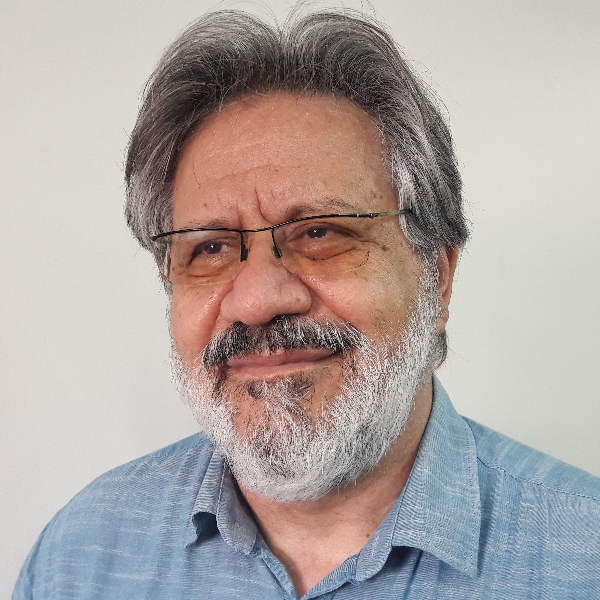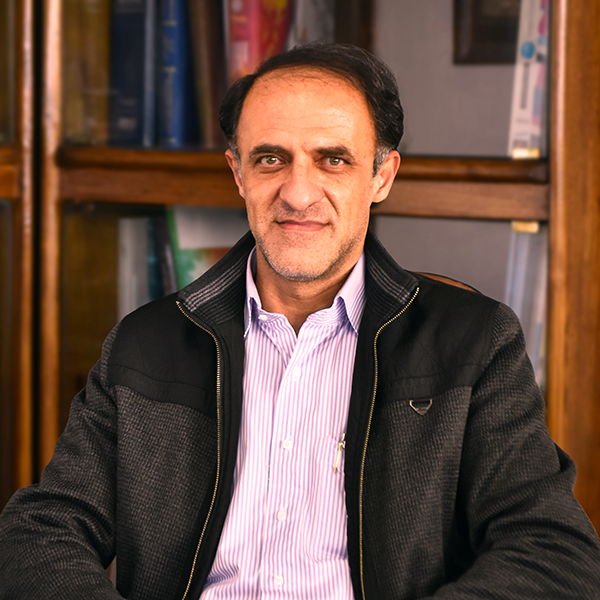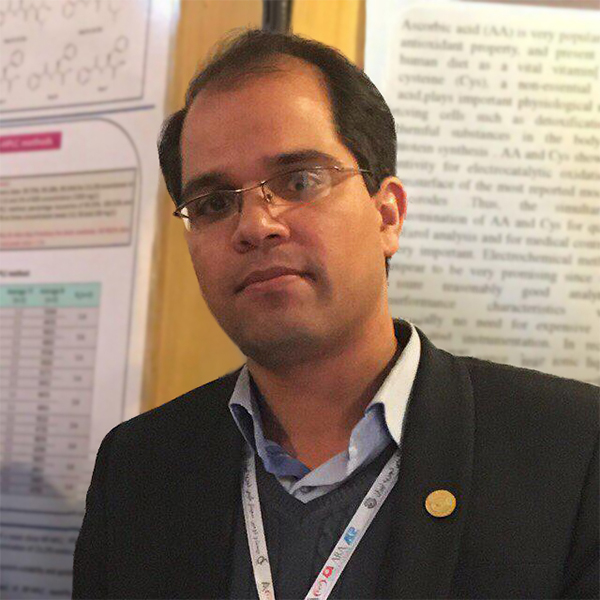شیمی تجزیه
شیمی تجزیه فرزند مدرن جستجوی باستانی است که چه چیزی در مواد نهفته است؟ در این کانی چه جیزی هست؟ شاید طلا باشد یا نکند هافنیم باشد؟ در نفت خام چه موادی داریم؟ ترکیبی که ساختهاید چیست؟ میتوانید آرایش اتمهایش را مشخص کنید؟ اینها همه پرسشهاییاند که شاید شیمیدانان تجزیه بخواهند بهآنها بپردازند. گرچه لولههای آزمایش و ظروف کماکان در کارهایشان حضور دارد، اما بسیاری از وارسیهای آنان اکنون با ماشینهای پیشرفته صورت میگیرد که بعضی از آنها از طیفبینی و بقیه تکنیکهایی توسعهیافته از سوی شیمیفیزیکدانان و شیمیدانان معدنی هستند.

دکتر حبیب باقری
استاد
- تکنیک های هایفندار (کروماتوگرافی، طیف سنجی جرمی )
- تکنیک های جداسازی ( SPE,SPME,SDME,SBSE,SPDE )
- آنالیز تجزیه زیستی و محیط زیستی
- سیستم های میکروسیالی
- طیف سنجی فلوئورسانس
- جاذب های نوین
Environmental and Bio-Analytical Research Group
:Toward ultra-trace analysis in complex real samples
The major goal in our research group is to use all possible aspects of chemistry to tailor different extractive phases from highly selective to more generic media. In overall attempts are made to employ these fabricated phases to develop and improve analytical methods for trace and ultra-trace determination of chemicals and drugs. Some of our interests are:
Electrospun nanofibers: Three–dimensional (3D) nanostructures in comparison with their 2D counterparts are a group of nanomaterials which are widely developed in a variety of fields. The unique pore features of 3D structures such as high bulk porosity (up to 95%), the isotropic structure and homogeneous fiber sizes (1–1000 μm) eliminate many constraints of 2D structure.
The major goal in our research group is to use all possible aspects of chemistry to tailor different extractive phases from highly selective to more generic media. In overall attempts are made to employ these fabricated phases to develop and improve analytical methods for trace and ultra-trace determination of chemicals and drugs. Some of our interests are:
Electrospun nanofibers: Three–dimensional (3D) nanostructures in comparison with their 2D counterparts are a group of nanomaterials which are widely developed in a variety of fields. The unique pore features of 3D structures such as high bulk porosity (up to 95%), the isotropic structure and homogeneous fiber sizes (1–1000 μm) eliminate many constraints of 2D structure.
Co-electrospinning introduces a novel class of nanofibers with core–shell structures. These structures in comparison with conventional nanofibers benefit from extra advantages including higher aspect ratios, flexibility in surface properties, specific mechanical function as well as more accessible adsorptive sites for extraction purposes.
Meso– and microporous materials: The fascinating metal organic frameworks (MOFs) represent extremely high surface area, huge porosity, sufficient thermal stability and uniform tailorable cavities. The successful implementation of nanostructured MOFs, individually or as composite, approves their capabilities as appealing sorbents in trace analysis of environmental and biological compounds.
Polyhedral oligomeric silsesquioxanes (POSSs), three–dimensional “cage–shaped” molecules, composed of a silicon–oxygen framework bonded to organic groups that make them compatible with a polymer matrix. The large surface area, uniform pore structure, rigidity and hydrothermal stability are the most highlighted properties of POSSs which design them as cross–linkers or individual extractive phases.
Green composites: Biocomposites are made from plant–derived fibers and crop/bioderived plastics, regarded as ecofriendly–oriented sorbents. Biocomposite-derived polysaccharides have been shown to be applicable as green extractive phases. The concern for environmental sustainability and the growing global waste problem seems to be resolvable by adapting these green composites.
Gradient substrates: The special feature of these surfaces is based on the existence of a gradient chemical composition from hydrophilic to hydrophobic. This interesting feature makes them applicable for the simultaneous and efficient entrapment of various compounds with different polarities and subsequent untargeted screening.
Superhydrophobic materials: The roughness of superhydrophobic materials increases the surface area and subsequently favors the adsorption process. On the other hand, the non–polar nature of surface is chemically desirable for extracting non–polar organic species.
Interpenetrating polymer networks (IPNs): IPNs are polymeric mixtures consisting of two or more networks which are at least partially interlaced on a molecular scale but not covalently bonded to each other. According to their synthesis methods and the types of polymers constitutes, IPNs with highly porous surfaces and hydrophilic/hydrophobic structures can be fabricated to improve their extraction capacity.
Miniaturized analytical instruments
Micro–oriented extraction techniques in conjunction with microfluidic devices are reliable, reproducible and susceptible to lower energy and reagent amount. In our research group, lab–on–a–valve (LOV) integrated micro–devices are considered as functional microfluidic platforms for simultaneous sample processing and appropriate introduction into the analytical instruments including GC and LC. Sandwich-format and double reservoir design are also developed to increase the extraction capacity and allow the analytes to diffuse from both sides of the microchannel. As expected, the analysis time is reduced while the extraction efficiency is improved. Altogether, combination of miniaturization technology with micro–oriented extraction technique allows us to utilize low amounts of sorbent in a microfluidic device to analyze low volumes of environmental samples within an appropriate and favorable time. These features will be of great benefit for further biological analysis.
Bioanalytical and analytical sensing systems
Development of facile, biocompatible and homogenous fluorescence assay is another research interest in our group. We are focused to design miniaturized, high-throughput and rapid turn-off fluorescence assay to trace imidazole-ring compounds in food industry. In-situ synthesis of carbon dots in the presence of analyte is the innovation approach in this work which leads to time effectiveness. In another study, a turn-on fluorometric method was developed for the detection of telomerase activity exploiting the combination of graphene quantum dots and graphene oxide through their assembly and subsequent disassembly in the presence of telomerase. This strategy is free from complicated synthesis and elaborate instruments, nevertheless, exhibits high sensitivity, high specificity and good reliability in the determination of telomerase as well as the ability to discriminate between normal and tumor cells. The quenching process is dramatically rapid and the whole detection process needs 120 min to complete.
Meso– and microporous materials: The fascinating metal organic frameworks (MOFs) represent extremely high surface area, huge porosity, sufficient thermal stability and uniform tailorable cavities. The successful implementation of nanostructured MOFs, individually or as composite, approves their capabilities as appealing sorbents in trace analysis of environmental and biological compounds.
Polyhedral oligomeric silsesquioxanes (POSSs), three–dimensional “cage–shaped” molecules, composed of a silicon–oxygen framework bonded to organic groups that make them compatible with a polymer matrix. The large surface area, uniform pore structure, rigidity and hydrothermal stability are the most highlighted properties of POSSs which design them as cross–linkers or individual extractive phases.
Green composites: Biocomposites are made from plant–derived fibers and crop/bioderived plastics, regarded as ecofriendly–oriented sorbents. Biocomposite-derived polysaccharides have been shown to be applicable as green extractive phases. The concern for environmental sustainability and the growing global waste problem seems to be resolvable by adapting these green composites.
Gradient substrates: The special feature of these surfaces is based on the existence of a gradient chemical composition from hydrophilic to hydrophobic. This interesting feature makes them applicable for the simultaneous and efficient entrapment of various compounds with different polarities and subsequent untargeted screening.
Superhydrophobic materials: The roughness of superhydrophobic materials increases the surface area and subsequently favors the adsorption process. On the other hand, the non–polar nature of surface is chemically desirable for extracting non–polar organic species.
Interpenetrating polymer networks (IPNs): IPNs are polymeric mixtures consisting of two or more networks which are at least partially interlaced on a molecular scale but not covalently bonded to each other. According to their synthesis methods and the types of polymers constitutes, IPNs with highly porous surfaces and hydrophilic/hydrophobic structures can be fabricated to improve their extraction capacity.
Miniaturized analytical instruments
Micro–oriented extraction techniques in conjunction with microfluidic devices are reliable, reproducible and susceptible to lower energy and reagent amount. In our research group, lab–on–a–valve (LOV) integrated micro–devices are considered as functional microfluidic platforms for simultaneous sample processing and appropriate introduction into the analytical instruments including GC and LC. Sandwich-format and double reservoir design are also developed to increase the extraction capacity and allow the analytes to diffuse from both sides of the microchannel. As expected, the analysis time is reduced while the extraction efficiency is improved. Altogether, combination of miniaturization technology with micro–oriented extraction technique allows us to utilize low amounts of sorbent in a microfluidic device to analyze low volumes of environmental samples within an appropriate and favorable time. These features will be of great benefit for further biological analysis.
Bioanalytical and analytical sensing systems
Development of facile, biocompatible and homogenous fluorescence assay is another research interest in our group. We are focused to design miniaturized, high-throughput and rapid turn-off fluorescence assay to trace imidazole-ring compounds in food industry. In-situ synthesis of carbon dots in the presence of analyte is the innovation approach in this work which leads to time effectiveness. In another study, a turn-on fluorometric method was developed for the detection of telomerase activity exploiting the combination of graphene quantum dots and graphene oxide through their assembly and subsequent disassembly in the presence of telomerase. This strategy is free from complicated synthesis and elaborate instruments, nevertheless, exhibits high sensitivity, high specificity and good reliability in the determination of telomerase as well as the ability to discriminate between normal and tumor cells. The quenching process is dramatically rapid and the whole detection process needs 120 min to complete.

دکتر سعید شاهرخیان
استاد
- طراحی و ساخت الکترودهای اصلاح شده متشکل از پلیمرهای هادی و مواد نانوساختار مختلف جهت استفاده در حسگرها، زیست حسگرها و ادوات الکتروشیمیایی تبدیل و ذخیره انرژی ( باتری ها و ابرخازنها)
Laboratory of Electrochemical Sensors, Biosensors, and Energy Storage/Conversion Device
Electrochemical Sensors and Biosensors: Nowadays, many analytical instruments used in environmental, food, pharmaceutical, or clinical laboratories, and also most of the commercial point-of-care devices work using chemical sensors or biosensors, as a whole or as a basic part. An electrochemical sensor is a device that transforms electrochemical information into an analytically useful signal. In this topic, our research focused on the fabrication of a sensitive and fast response electrochemical sensing platform based on various nanomaterials as a recognition system for determining biological or pharmaceutical species. In addition, a biosensor is a device that contains a biological, or bioinspired recognition layer with unique specificity toward target analytes. Hence, recent work in our laboratory has also sought to develop a biosensor based on DNA and aptamers as a recognition element for detecting cancer biomarkers and bacteria.
Supercapacitors and fuel cells: Supercapacitors are electrochemical devices that have exceptional power densities and lifetimes, however, their energy density is limited. In our group, we focused on designing new electrode materials with tailored nanostructures using transition metal/carbon nanomaterial/polymer compounds as active components in flexible supercapacitors to improve their energy whilst maintaining the power density. Moreover, during the recent years, fuel cells as a clean and new energy conversion source, have attracted more attention, and thus will help solve the global problems of energy supply and a clean environment. Despite their great promise, commercialization has been hindered by lower than predicted efficiencies and the high cost of electrocatalysts in the electrodes. Our research focus is directed to the development of non-precious metal catalysts and highly selective catalysts for fuel cell catalysis and other energy-relevant applications.
Electrochemical Sensors and Biosensors: Nowadays, many analytical instruments used in environmental, food, pharmaceutical, or clinical laboratories, and also most of the commercial point-of-care devices work using chemical sensors or biosensors, as a whole or as a basic part. An electrochemical sensor is a device that transforms electrochemical information into an analytically useful signal. In this topic, our research focused on the fabrication of a sensitive and fast response electrochemical sensing platform based on various nanomaterials as a recognition system for determining biological or pharmaceutical species. In addition, a biosensor is a device that contains a biological, or bioinspired recognition layer with unique specificity toward target analytes. Hence, recent work in our laboratory has also sought to develop a biosensor based on DNA and aptamers as a recognition element for detecting cancer biomarkers and bacteria.
Supercapacitors and fuel cells: Supercapacitors are electrochemical devices that have exceptional power densities and lifetimes, however, their energy density is limited. In our group, we focused on designing new electrode materials with tailored nanostructures using transition metal/carbon nanomaterial/polymer compounds as active components in flexible supercapacitors to improve their energy whilst maintaining the power density. Moreover, during the recent years, fuel cells as a clean and new energy conversion source, have attracted more attention, and thus will help solve the global problems of energy supply and a clean environment. Despite their great promise, commercialization has been hindered by lower than predicted efficiencies and the high cost of electrocatalysts in the electrodes. Our research focus is directed to the development of non-precious metal catalysts and highly selective catalysts for fuel cell catalysis and other energy-relevant applications.

دکتر محمدرضا هرمزی نژاد
استاد
- حسگرها و حسگرهای زیستی مورداستفاده در نانوذرات پلاسمونیک و نورتابی
- سنسور های نوری الهام گرفته از طبیعت
- سنسور های آرایه ای نوری مبتنی بر نانوذرات
- نورتابی شیمیایی
Spectroscopy of Nanomaterials
The main research interests of Hormozi-Nezhad’s group mainly focus on sensing and biosensing using plasmonic and luminescent nanoparticles (NPs). The shape-selective synthesis of various metallic NPs and the investigation of the surface plasmon properties of gold and silver NPs, together with the optical properties of diverse size of quantum dots (QDs) and carbon dots (CDs) are used for the determination and discrimination of important chemically and biologically active compounds. In addition, we have utilized array based sensing as a powerful approach toward the discrimination of chemically diverse analytes. Utilization of nanomaterials in design of cross-responsive sensor elements, these systems are strive to produce unique responses to each analyte, in a fashion similar to the mammalian olfactory system

دکتر هادی پرستار
دانشیار
- توسعه روشهای مختلف کمومتریکس و یادگیری ماشین با هدف کالیبراسیون و طبقه بندی
- توسعه نرم افزار سهل العمل برای اجرای روش های کمومتریکس و یادگیری ماشین
- کاربرد های روش های کمومتریکس و یادگیری ماشین در آنالیز اطلاعات کروماتوگرافی، طیف سنجی و تصویربرداری فراطیفی
- کاربرد های روش های کمومتریکس و یادگیری ماشین در حل مشکلات محیط زیستی، متابولیکی، انگشتنگاری و اصالت مواد غذایی
Chemometrics Research Lab
Regarding the importance of separation science in general and especially chromatography in the analysis of complex samples and the role of chemometrics in the analysis of different types of chromatographic data involving hyphenated (e.g. GC-MS) and multi-dimensional (e.g. GC×GC-FID, GC×GC-TOFMS), we are working on development and application of different chemometrics methods such as multivariate curve resolution (MCR), multivariate optimization (experimental design), multivariate calibration and recently pattern recognition for the analysis of chromatographic data.
In addition, we are working on development of novel data analysis tools mainly based on machine learning and especially deep learning for hyperspectral imaging (HSI) techniques (vibrational and mass spectrometry) as well as portable (handheld) near-infrared (NIR) spectrometers.
Development of new and user-friendly software for non-expert users (e.g. MCRC Software, MVC app and RMet) composes another part of our researches.
The developed methods are mainly utilized for solving environmental monitoring, plant/human metabolomics and food authenticity problems.
Regarding the importance of separation science in general and especially chromatography in the analysis of complex samples and the role of chemometrics in the analysis of different types of chromatographic data involving hyphenated (e.g. GC-MS) and multi-dimensional (e.g. GC×GC-FID, GC×GC-TOFMS), we are working on development and application of different chemometrics methods such as multivariate curve resolution (MCR), multivariate optimization (experimental design), multivariate calibration and recently pattern recognition for the analysis of chromatographic data.
In addition, we are working on development of novel data analysis tools mainly based on machine learning and especially deep learning for hyperspectral imaging (HSI) techniques (vibrational and mass spectrometry) as well as portable (handheld) near-infrared (NIR) spectrometers.
Development of new and user-friendly software for non-expert users (e.g. MCRC Software, MVC app and RMet) composes another part of our researches.
The developed methods are mainly utilized for solving environmental monitoring, plant/human metabolomics and food authenticity problems.
